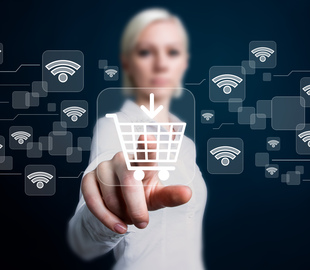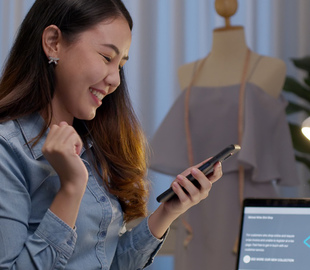Wearable payments: A growing trend in the consumer journey
Social trends change what we wear and, now, increasingly, the way we pay.
With consumer preference for everything moving rapidly towards ‘contact-free’, wearable payment technology is finding new momentum. Driven in part by the pandemic, the popularity of so-called ‘clean’ payments – everything from payment-enabled rings, bracelets, key fobs, fitness bands, stickers, cufflinks (plus, of course, phones) – is rapidly accelerating around the world.
These battery-less devices are known as passive wearables and are increasingly showing up in surprising new ways as they attract the attention of designers and manufacturers in the jewellery and fashion worlds. A well-known French designer recently created fashionable rings to carry payment information. New designs for bracelets and cufflinks include payments technology, while wristbands and intelligent fabrics can discreetly weave interactive sensors into jackets and other clothing.
Technology makes it possible
For you and your business, understanding the growing trend of wearable payments is key.
The path of adoption for these new devices kicked off more than a decade ago with the rise of wearable tech, such as fitness trackers, and the introduction of smart watches. While fashions and trends can lead to mixed marketing results for the uptake of different products, consumer acceptance overall has grown with a surge in the appeal for many devices.
The popularity of so-called ‘clean’ payments is rapidly accelerating around the world.
As consumers have increasingly opted for comfort in recent years, the potential for payment-enabled devices has also increased. With advances in technology, consumers can carry or wear their favourite payment methods while leaving their cards and wallets at home. Today, these passive wearables are finding uses for payments in resorts and hotels, amusement parks, music festivals and concerts, cruise ships, transit, sporting events and campuses.
A recent survey of 15 countries by 451 Research found that Poland, Bulgaria, Greece, Peru, South Africa, Italy and Spain were among the top countries with the greatest interest in these payment opportunities.1
The appeal is clear. Customers choosing to link an account to these reloadable devices – with a bank, debit or credit card – can avoid the need to continuously add funds. Indeed, in the 451 Research survey, the most popular method for funding a passive wearable wristband, for example, was through automatic uploads from a bank account.1
Passive wearables are finding uses for payments in resorts and hotels, amusement parks, music festivals and concerts, grocery stores, fast-food outlets, transit, sporting events and campuses.
Even without traditional banking relationships, consumers can enjoy stored-value flexibility. For travellers and tourists, or anyone without a bank, these reloadable options can be invaluable. Users need only locate a participating merchant or stand-alone kiosk and insert their cash in order to top-up the available funds on the device or accessory. For consumers without an account, or for those who prefer not to link them, these reloadable devices provide a valuable payment alternative.
By combining functionalities, businesses can allow consumers to access their hotel rooms, loyalty sign-ins, concert tickets, transit passes, and even more. Shops, restaurants, hotels and entertainment venues can provide guests with enhanced services and product options by embedding payment and other offers into various devices.
Are consumers ready?
The take-up of these new payment capabilities, while growing worldwide, differs among countries and regions. For example, some 54% of global consumers said they were “highly comfortable” with contactless payments in general, while nearly two-thirds (65%) said they wished more places accepted contactless options, citing speed and convenience as their top two reasons, according to the 451 Research survey.1
In particular, Poland and Australia stood out as among the most receptive countries to contactless payments, with 78% and 64% of consumers, respectively, saying they actually “prefer” that method.
New horizon for merchant opportunities
Not only do new payment wearables provide convenience for consumers, they also offer merchants a new way of capturing and retaining customers. Merchants increasingly need to recognise the trends that drive customer preferences. Surveys have shown that preferred payment method acceptance is the most important attribute when consumers are shopping at stores.2 With the rise in wearable payments, working closely with a payments network partner can help ensure you’re ready.
The benefits are many. In addition to expanding payment and marketing methods, the information gleaned from customer transactions provides your business with smarter insights into your customer’s behaviour. By tying purchase data from payment-enabled wearables into loyalty offerings and cross-selling incentives, marketing efforts can be expanded to open-up further opportunities to generate sales. These carry-everywhere objects, embedded with identification and individual account data, allow you to incentivise your customers in real time at the checkout. These low-cost objects can also be branded as loyalty tools, which consumers consistently say increases their likelihood of shopping with a merchant.3
These low-cost objects can be branded as marketing tools, as well as payment and loyalty methods, which consumers consistently say increases their likelihood of shopping with a merchant3
With so many new payment alternatives, merchants can also provide point-of-sale (POS) options that don’t require customers to stand in line to use a fixed terminal. Employees working in-store, at-kiosk, or at outside retail stands can use mobile scanners and Near Field Communication (NFC) devices to quickly read payment information with just a tap from a customer’s enabled bracelet, ring or watch.
Stay tuned for more
As payment technology advances in both convenience and security, the possibilities for creative and increasingly attractive payment options will grow.
New devices, platforms and applications – and, ultimately, increased acceptance – are in the works.
These new customer journeys, made faster and simpler through wearable payment methods, will continue to set new customer expectations. As consumers become more accustomed to living contact-free lives, you and your business should prepare now to take advantage of tomorrow’s consumer behaviour.
By working closely with your payments partner you can capture the opportunity that accompanies this growing trend. Ensuring the acceptance of payments in the style and manner that consumers prefer is a most effective way to deliver the experience that customers want.
Content accredited to Discover® Global Network
Sources:
1 451 Research, July 2020. Creating Engaging Customer Experiences with Passive Wearable Payments.
2 C+R Research Study of 1,808 Discover Cardholders, August 2020, commissioned by DFS Services LLC.
3 451 Research, March 2020. Global Merchant & Consumer Study: In-Store Payment Trends.








